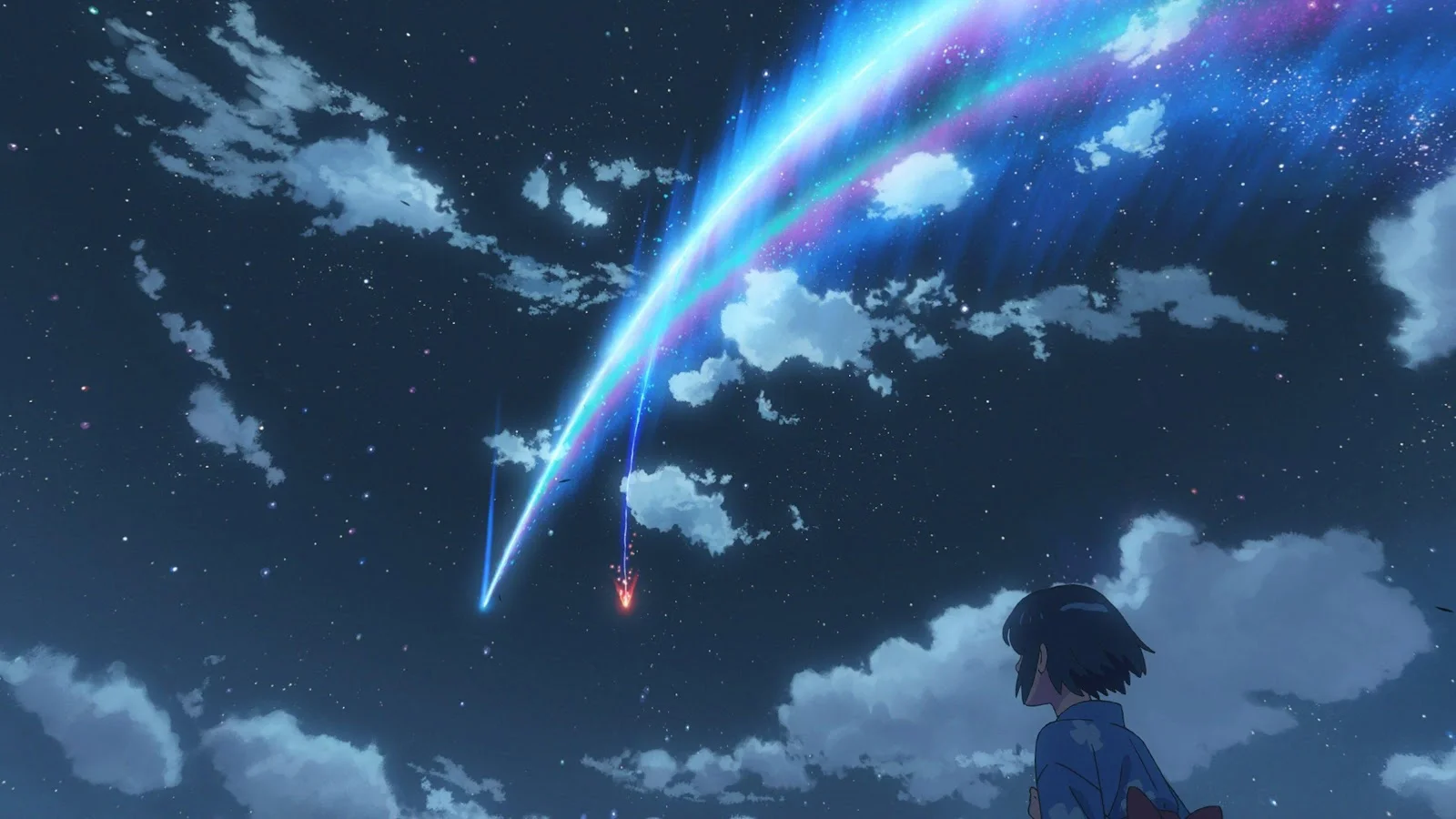Written by Qalam’s regular contributor, film historian Alexei Vasilyev, this series of essays explores the oeuvres of the greatest Eastern film directors from different times. The portrait gallery continues with Japanese director Makoto Shinkai.
A Cat in Winter and the Evaporated Dreams of Fifteen-Year-Olds
The Japanese anime director Makoto Shinkai is often described as an incurable romantic—and for good reason. For the past quarter century, his work has been devoted to immortalizing the ephemeral—rain, snow, the lacework of sunlight in a child’s memory, cigarette smoke and the steam from hot coffee, a song on the radio that makes a hand tremble as it reaches for an item in the supermarket, buildings doomed to demolition. He strives to ground and materialize the reality of dreams, the tears that disappear faster than the names and faces of those you loved in dreams. Behind a banal phrase like ‘Haven't we met somewhere before?’—the kind of line boys use to pick up girls on the street—he uncovers the mysteries of the universe, enough to craft the plot of a feature-length film. This is precisely what happened with Your Name (2016), which became the highest-grossing anime in history.
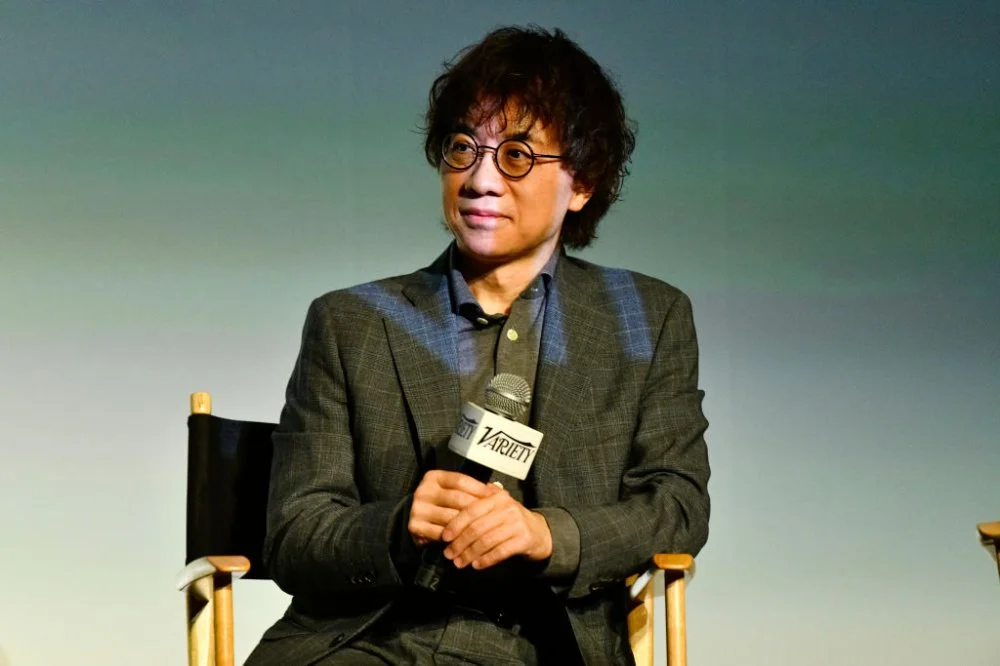
Director Makoto Shinkai attends Variety Artisans Screening Series presents "Suzume" at Harmony Gold on November 20, 2023 in Los Angeles, California /Jerod Harris/Variety via Getty Images
In truth, the fact that three of his films rank among the top ten highest-grossing anime—besides Your Name, there's Weathering with You (2019) and Suzume (2022)—makes us, people today, incurable romantics. While these films include elements of adventure, Shinkai’s most beloved works among his true fans—5 Centimeters Per Second (2007) and The Garden of Words (2013)—focus on everyday life. They dwell on the yearnings of fifteen-year-olds, which can be encapsulated in the phrase ‘Somewhere, there's a heart.’
Indeed, fifteen is the favorite age for characters with anime creators—the age of first love, first escapades, decisions, and the urge to run away in pursuit of one's calling. But while Shinkai's protagonists’ peers in other anime fly starships, solve murders, and battle evil spirits, the lives of Shinkai's fifteen-year-olds are a chain of evaporated dreams, unfulfilled embraces, and unsent messages. Instead of conversations, there are internal monologues; instead of their own words about love, there's an old song randomly playing on the radio. The camera, mimicking the shy gaze of a teenager, rarely lifts its lens to meet the eyes across from it; instead, it hides its gaze beneath feet, on store shelves, in the sky crossed by high-voltage power lines, in the sensor of a steam cooker, or on a subway handrail.
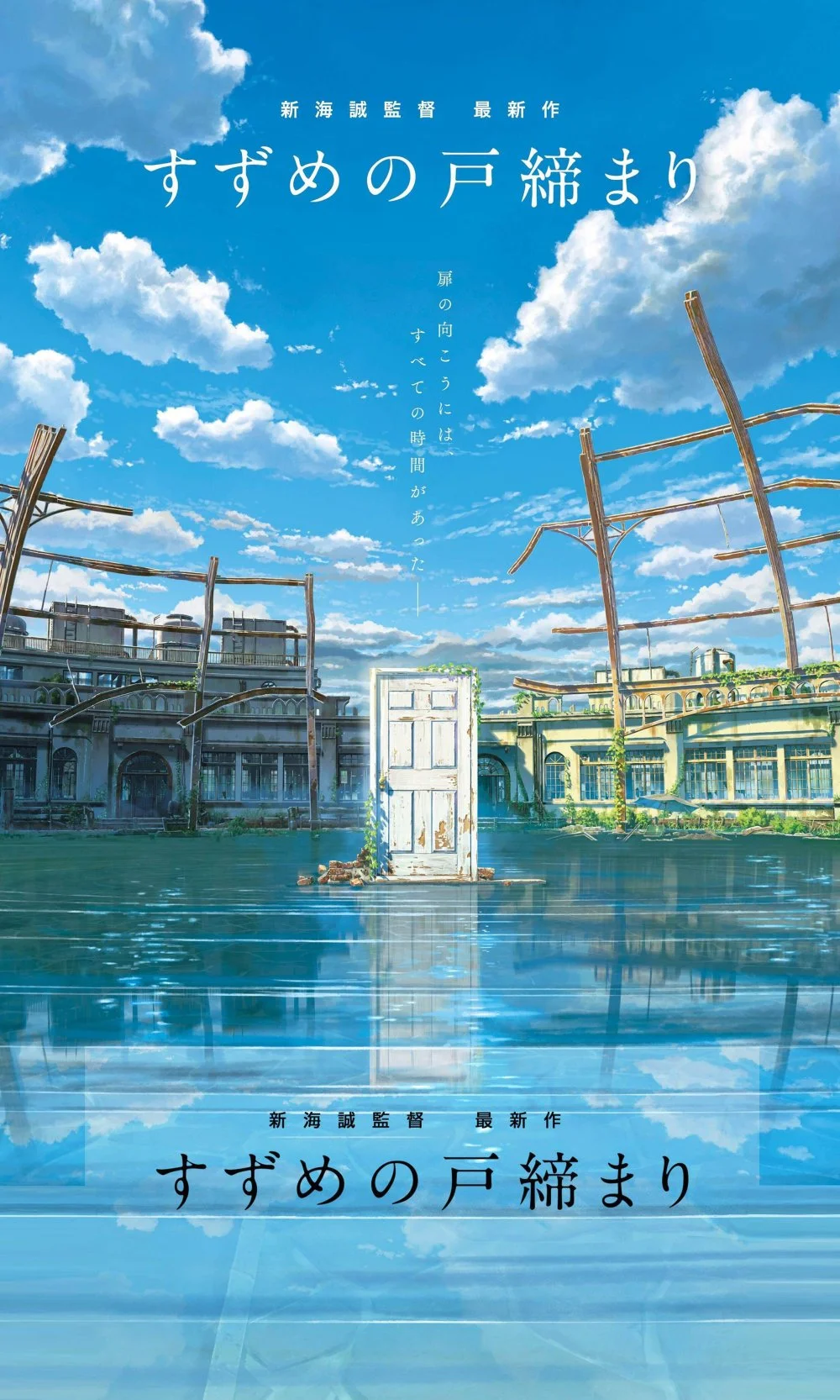
Suzume no tojimari. Directed by Makoto Shinkai (2022)/Prod DB © Toho Company - Aniplex - CoMix Wave Films - East Japan Marketing & Communications Inc/Alamy
Shinkai’s signature technique—‘looking anywhere but there’—was discovered early, when he was a twenty-three-year-old employee at a company producing visual novels. He worked as a graphic designer but spent his free time drawing short, two-minute, black-and-white animations literally on his lap. These films had no dialogues or even internal monologues; instead, they relied on captions. Due to his primary job, each mini-film took two years to complete. One of them, Other Worlds (1998), featured a montage of flickering images of gliders and birds flying past the window of a suburban train interspersed with scenes of a sweltering summer day spent locked inside an apartment. The sun was pinned to the floor under the edge of a barely swaying curtain, and it wasn’t even the wind that moved it but a desperately spinning fan. A girl lay on the floor, wilting from the heat. On the train, she huddled close to a boy lost in his own sadness. The film ended with the caption: ‘Someday, you’ll find your true second half. Until then—I’ll be with you.’ The scene felt like an exercise in pure melancholy. Shinkai had yet to make his films (and his mark!), and he didn’t yet have an audience who realized that in his world, nothing is more permanent than the temporary and nothing more faithful than the fleeting.
Other Worlds was set to Erik Satie’s Gymnopédie No. 1, a piano piece beloved, and which has been repeatedly embraced, by Eastern filmmakers. You can hear it in Kim Ki-duk’s Address Unknown (2000), and it even became the central theme in I’ll Come to You When the Weather Is Fine (2020), which is the most meditative of dramas. Perhaps this universal theme—where a finger brushing high-octave keys seems to either sift through memories, flip through photographs, or bid farewell to untouched seasons—was ‘sold’ to them by Shinkai, who found the perfect visual interpretation. In any case, by 1999, Shinkai’s early amateur pieces, including Other Worlds, began to be pulled into the spotlight, propelled by the success of his slightly longer (five-minute) black-and-white film She and Her Cat, which started winning awards at niche anime and animation festivals.
In the film, the chaotic life of the apartment, where, over time, a young woman loses her love, is seen through the eyes of a cat she adopted in the spring. The film is divided into chapters corresponding to the seasons, and Shinkai would later use this technique often, flipping through months and, in some way or another, through calendars. Clearly defined times and seasons are narrative inevitabilities for the Japanese, who even start their letters by noting the day, time of day, and weather outside. And something that would soon become obvious in this small detail was already evident—Shinkai is an innately Japanese creator. Many years later, when he began to make his box office hits featuring elements of fantasy and fairy tales, it became clear that the sense of poeticized reality and the animation of the everyday in his works were dictated by the fact that these elements grew not from the author’s wild individual imagination but from the philosophy of Shintoism,i

She and her cat. Written by Makoto Shinkai/From open sources
She and Her Cat ends in winter, and from that point onward, in Shinkai’s cinema, winter, which forces one to seek shelter and warmth, becomes a symbol of fulfilled love and shared feelings. The cat says, ‘In the endless darkness, our little world spins. The seasons change, and now winter has come. Her snow-covered figure, the rumble of dark clouds over a dark field, her soul, my feelings, and our room—snow obscures all of this. Only the sound of the train she’s leaving on reaches my keen ears. To me, and probably to her too, this world—seems like we love it.’

She and her cat. Directed by Makoto Shinkai, 1999/From open sources
Winter is a trap for two, and love—so fragile and elusive a substance—requires another trap to be realized. This is one of the first thoughts Shinkai would share with his audience, and as his mastery of audiovisual storytelling evolved, he would express and capture these ideas in the nets of his plots. Soon, he was asked to make a music video for pop diva Hiromi Iwasaki, whose pure and powerful voice had been comforting the Japanese people since the mid-1970s, to the extent she even recorded the Pokémon song for the legendary anime series. ‘In the blue, blue sky, your smiling face floats toward me, and that smile gives me strength,’ Iwasaki’s song begins while on-screen, an animated hamster starts running across the steppe, past a lake, through a field, under a blue sky kissed by white clouds, only for the camera to pull back and reveal that for him, this entire world exists within the wheel he runs in under the gentle smile of his owner, tired from external worries beyond the confines of this apartment, table, and the hamster wheel. The lyrics ‘In my thoughts, all about you’ echo the hamster's confined yet comforting reality.
Tokyo Stories
These small yet striking successes caught the attention of CoMix Wave, a company that supplied software to the firm where Shinkai was employed. Impressed with his work, CoMix Wave gave him a budget to produce an original video animation (OVA; also sometimes abbreviated as OAV (original animation video), a term used in the anime world for special releases, typically around twenty-five minutes long, intended not for television but for sale on discs. Since Shinkai wasn’t working on any franchise, he was given carte blanche to create an original mid-length anime, and the disc was set to include the smaller films he had already created, and thus, the first anthology of Shinkai’s films was being prepared for release, marking the beginning of a beautiful friendship between him and CoMix Wave. The project was so successful that for the production of Shinkai’s second feature-length film, 5 Centimeters per Second, a new studio, CoMix Wave Films, was spun off from the company, becoming Shinkai’s personal film enterprise. However, starting with Your Name, the studio’s capabilities were no longer sufficient to support the wide global distribution support required by Shinkai’s recent works, and this was handled by Japan’s largest and oldest film company, Toho.
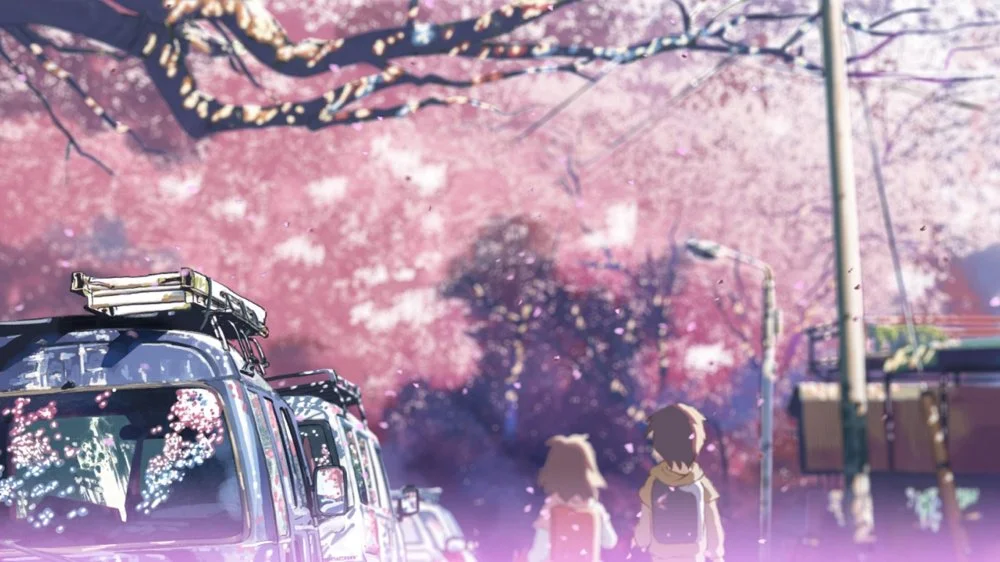
5 Centimeters Per Second (Directed by Makoto Shinkai, 2007)/Makoto Shinkai Animation/Alamy
Shinkai’s OVA was Voices of a Distant Star (2002), an anime about two high-school sweethearts exchanging text messages. The male protagonist remains on Earth, continuing his studies and eventually stepping into adulthood, while the female protagonist becomes a space pilot for an army pursuing aggressive extraterrestrial beings known as Tarsians. As the army drives the Tarsians further away, the heroine is forced more and more light years away from Earth. Soon, her messages start arriving with a year’s delay and eventually, the hero stops receiving them altogether. Resigned to this fate, he decides, ‘And then I decided that my heart would be cold and strong. This door will never open. I won’t knock on it forever; I’ll grow up, even if it’s alone.’
Needless to say, except for the prologue, where the characters watch white trails of rockets flaring in the sky at sunset, and the girl shares her dream of one day flying on one, the film is devoid of dialogue. The story is told through text messages, sometimes appearing in their original, typed form, but more often as voice-over monologues. In the meanwhile, images of railway crossing gates rising, a narrow passage under a bridge, swaying subway handrails, the sun slipping away like water at sunset from a balcony flash on-screen, representing scenes that he has seen before his eyes for years and that she has seen in her dreams all this time.
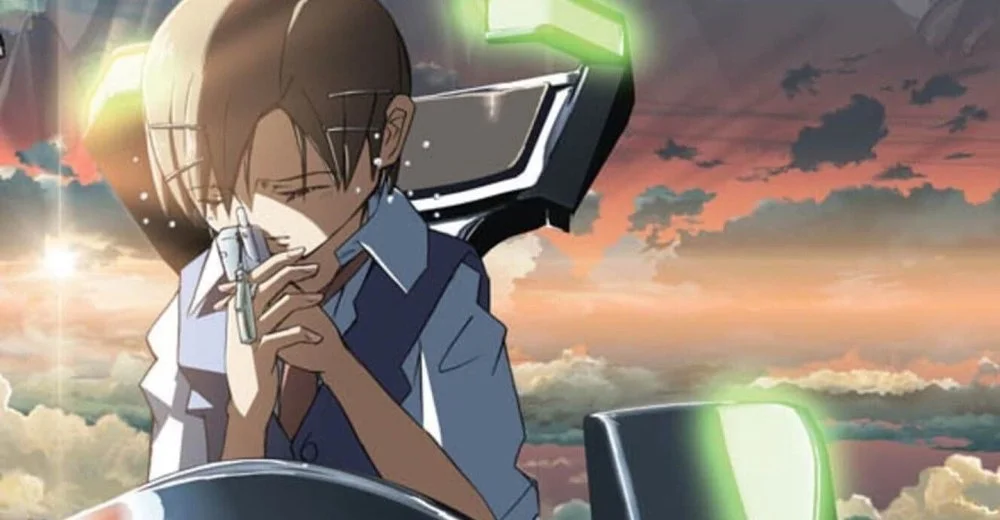
Voices of a Distant Star (Directed by Makoto Shinkai, 2002)/From open sources
Voices of a Distant Star can’t be really considered one of Shinkai’s undisputed masterpieces—a third of the film consists of cosmic imagery and battles, and this third is somewhat monotonous and repetitive. To this day, Shinkai’s attempts at fantastical visions haven’t entirely been successful. He is the greatest poet of the everyday, a magician who materializes elusive feelings that, in real life, we’d struggle to describe. In this sense, Voices is like a drop of water that fully reflects Shinkai’s future imagery and many of the major themes he has explored through his career. This is where his universe began to take shape. Amongst his devoted fans, many believe that all his films' stories unfold simultaneously—especially since the relativity of time is one of Shinkai’s themes—in a unified, interconnected space.
This opinion isn’t without merit. The narrow passage under the bridge that appears in the heroine’s dream in Voices will reappear seventeen years later in Weathering with You, though almost unrecognizable, transformed by a prolonged storm and the constant rain that shapes the film’s world. In Voices, the passage is bathed in the lace-like light of the setting sun. The barriers of small railway crossings seen here will appear in almost every subsequent film, and one such crossing will be the scene of a lyrical climax in "5 Centimeters per Second"—the moment of looking back to see if she looked back.

«Children Who Chase Lost Voices» (2011)/ CoMix Wave Films
A similar lyrical climax in "Your Name" will take place on a staircase that we will later speed down on a moped in "Weathering with You." We will also dash across a metro bridge over the Shibuya crossing, which is actually closed to pedestrians but allows three thousand people to cross at once—a recurring motif in his films.
But here we must talk about the real Tokyo, which is part of Shinkai’s universe. Film after film, he passionately and diligently depicts his favorite places in different seasons and lighting conditions, Yoyogi district like Stalinist high-rises, whose gloomy color palette Shinkai captures as particularly ominous and unsettling when portrayed in the rain—in both "The Garden of Words" and "Weathering with You."
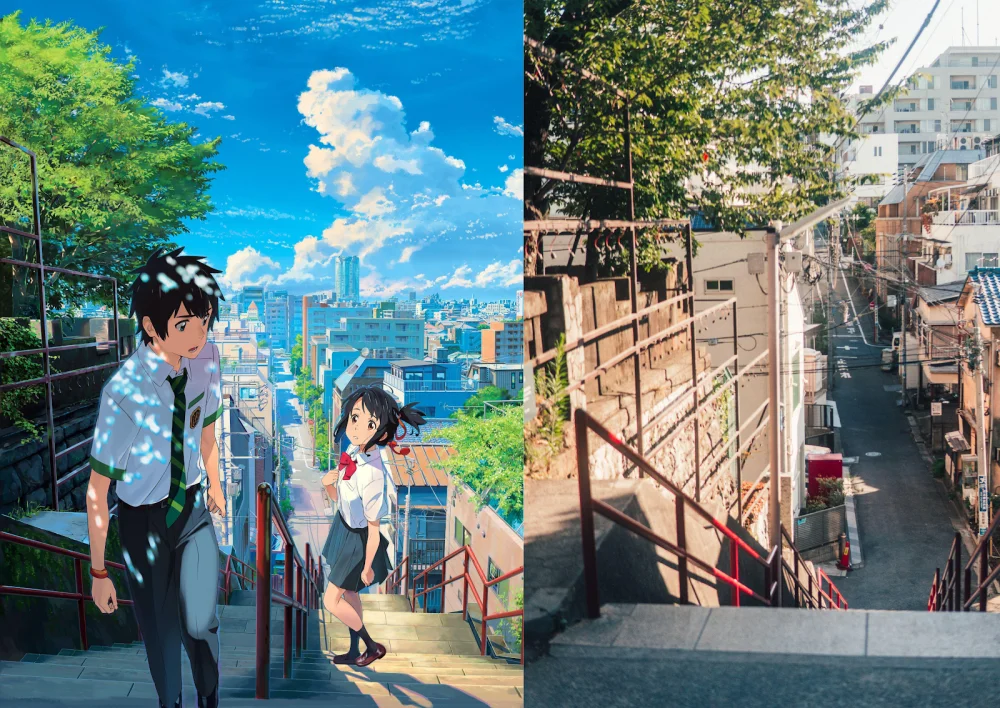
A comparison of a frame from the anime "Your name" and the real place in Tokyo/ Alamy
After the release of "5 Centimeters per Second", a sort of game emerged—people, not just Japanese, searched for the locations in Tokyo captured by Shinkai, photographed them, trying to replicate the exact angles and lighting in which they appeared in the director’s frames, and posted them online. After "The Garden of Words," which immortalized Shinjuku Park with all its pavilions and bridges over ponds, this game became so popular that soon Shinkai-themed tours were being organized. And although, as we’ve noted, Tokyo serves more as a unified space for Shinkai’s characters, he fuels the fire by giving cameo roles to the main characters from his previous films in his subsequent ones: for instance, the cat Chobi from the short film "She and Her Cat" returns in the feature "The Place Promised in Our Early Days," and the hero of "5 Centimeters per Second", upon encountering him again, even asks about his girlfriend from the first film, Mimi.
This attachment to the same places in Tokyo—whether they are postcard-perfect, bustling, or known only to residents of certain neighborhoods—along with the same faces, and even, in the case of cats, the same expressions, does not stem from a desire on Shinkai’s part to turn his work into a collection of sidequels.i
- The smell of school chalk.
- The sound of midnight trucks.
- The scent of asphalt in the rain.
- Noboru, all of this, that I had…
- All this time…
- ... I would have liked to share with you,
- Mikako.
For Shinkai, love is about living day by day together, with each other and the world—with the barriers and bridges, cats and passersby, sun and rain, everything that lives, changes, and disappears. For instance, the seven-story Kaikan building in the Yoyogi district, built in 1969, disappeared two weeks after the premiere of "Weathering with You." Knowing that one of his favorite childhood places was soon to be demolished by a wrecking ball, Shinkai immortalized it while it still stood, with its now-rusty staircases, placing red torii gates on the roof—serving in this rainy summer tale as a portal to summon the sun. Love for Shinkai, though he never calls it that, is a love for the homeland shared by two.
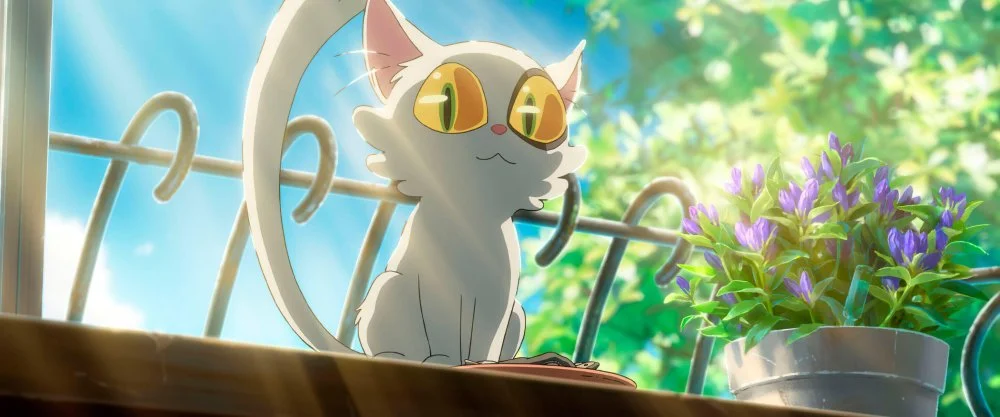
Mystical cat Daidjin. “Sudzume”/Alamy
Shinkai's collaboration with Taisei Corporation, Japan’s largest construction company, is telling in this regard. Between 2008 and 2014, he created four promotional videos for the company. A fan of the man-made landscape, shaped by people as new needs arise, he eagerly took on the project. With the same emotional depth with which he mourns the loss of buildings and infrastructure that seemed to him as a child to be as immutable a part of the world as trees or the sun—though trees are also fleeting, and each new turn of the historical spiral calls into question the permanence of the sun overhead—he celebrates the erection of new structures that, in turn, will become an unshakable part of the landscape for those born after us.
In these videos, he captured the construction of the tunnel under the Bosphorus, connecting Asia and Europe, Sri Lanka’s first highway, and the new airport in Hanoi. The first video in the series also focused on airport construction, this time in Doha, Qatar’s capital. The worker whose internal monologue accompanies the video speaks of how, these days, he often looks up at the sky, at the clouds that, unlike him, will soon float above his homeland as well. And of the tears that, he’s sure, will fill his eyes on the day this construction is completed and he can finally return home.
"LONELY PLATFORMS AND THE SHOEMAKER'S HANDS"
After "Voices of a Distant Star," Shinkai began work on his first full-length feature, "The Place Promised in Our Early Days" (2004). From the heights he has reached today, the film might be seen as a disappointment, but it was rightfully met with great enthusiasm at the time. Despite its dramatic imperfections, it was clear that something new and beautiful had emerged in the world of anime. The story of two high school friends, their love for a classmate, and the dream they pursued is set in such a tangible environment that the emotions can almost be felt physically. Like when the heroine lingers in the train vestibule, and the contrast between its cool darkness and the blinding, sweltering heat of the sunny platform where her friends had jumped off moments earlier assaults her senses. Like the grass at their feet, which, in all its lush green, loses its sharpness of outline in the afternoon sun. These scenes would later be echoed in live-action format by Ryusuke Hamaguchi (whom we’ll discuss separately) in "Happy Hour" (2015), where the heroine, upon learning that her classmate is pregnant by her son, walks among green trees, their silhouettes blurred by the midday heat, suddenly realizing that, although she is not old, she is free from her role as a mother, that her son is ready to become a father, and begins a conversation with him in a completely different manner as if he were a charming passerby.
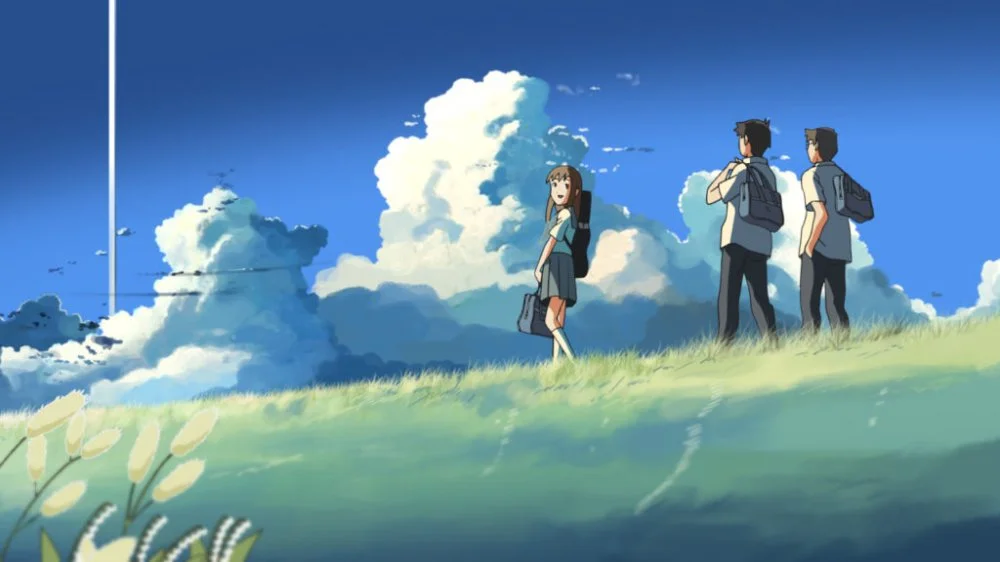
«The Place Promised in Our Early Days» (Directed by Makoto Shinkai, 2004)/From open sources
In "The Place Promised in Our Early Days," the action takes place in an alternate reality where Japan, after the war, was divided: one part remained occupied by the United States, while the northern island of Hokkaido was ceded to the Soviet Union, which remains the USSR to this day. Since 1974, the USSR has been building a tower on the island, the top of which has long since reached the sky. The two friends, living on American territory and sighing, "The Soviets sure know how to build!", are building a plane to fly around the tower and see what it is. As they grow older, they become entangled with the security services. The film's final scenes unfold when the boys already know that America will attack the USSR in five days. In the scenes where the protagonist drinks what might be his last peaceful coffee in Tokyo while behind him, trains loaded with military equipment rumble northward over the bridge full of exhilarating tension. In this film, Shinkai attempts to marry quantum physics with Shintoism, but the synthesis he would achieve in "Your Name" does not occur here: the ending leaves the viewer unemotional.
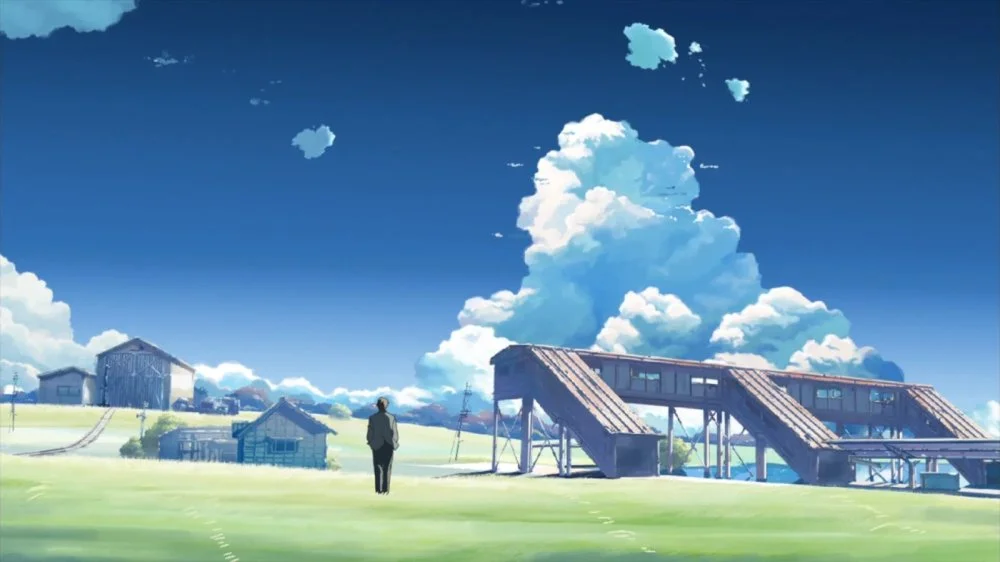
«The Place Promised in Our Early Days» (Directed by Makoto Shinkai, 2004)/From open sources
"Feeling this, Shinkai retreated to everyday life, a move that gave the world two films that remain the most beloved among his devoted fans to this day. Honestly, we still hope that one day, he will set aside fairy tales and tell at least one more "everyday story." Inevitably, debates arise: which of these two films—"5 Centimeters per Second" (2007) or "The Garden of Words" (2013)—is more significant. I myself have been drawn into these debates more than once, even once with the owner of a comic book store. And here’s the interesting thing: these debates, in essence, are not really debates but a way to instantly understand the person opposite you. Because the absolute perfection of both films is not in question; it’s more about which one resonates closer with your deeply personal experience.

The Garden of Words (Directed by Makoto Shinkai, 2013)/From open sources
Although both are dear to me, I choose "5 Centimeters per Second", perhaps because right after high school, I went to university in Moscow and often returned to my hometown by night train in the winter. The 13-year-old protagonist travels by train to a remote area where the girl he befriended in elementary school has moved with her family from Tokyo. Now, his own family is moving to Tanegashima Island, making it even harder for him to reach her in Tochigi. They agreed to meet at her station at 7 PM on March 3rd. But a heavy snowfall begins, causing all the trains to be delayed and even stuck on the tracks. Shinkai remarkably captures the state of a teenager being drawn into an impenetrable cold desert, at the end of which he is promised the warm light of love. The bustling transfer station Shinjuku, with its displays, clocks, electronic schedules, thousands of pairs of elegant shoes, and briefcases, transitions to small stations where groups of men huddle around the only yellow window, where they are served drinks and hot sandwiches. Instead of chrome trains, there are green cars with ice in the vestibule and empty rows of wooden seats. And at 7 PM, the time tragically becomes a fact of the past. Outside the window, besides the night and snow, it’s 1995, and there is no way to call or send a message. When he finally arrives closer to midnight, ankle-deep in snow, on an utterly lonely platform, the tiny station building has 12 plastic chairs arranged in a "P" shape, red and blue, the kind that Czechoslovakian trams were equipped with in the 1980s. She is waiting in one of them. His loneliness is replaced by peace, the most precious of feelings, a shared dinner, and a kiss, from which he understands "what eternity means, what the heart means, what the soul means."
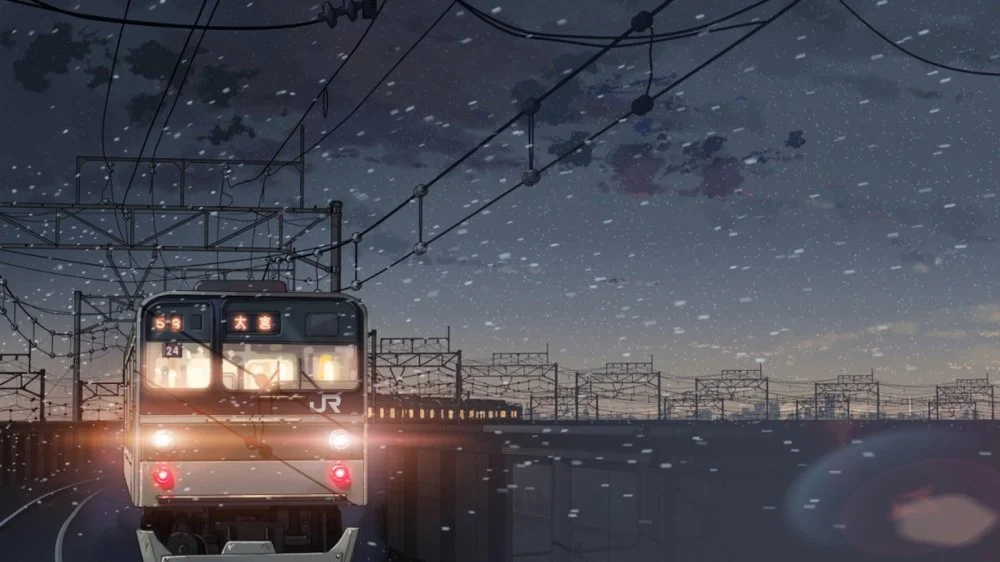
5 Centimeters Per Second (Directed by Makoto Shinkai, 2007)/Makoto Shinkai Animation/Alamy
"A recurring motif in the film is a bird flying in the sky, but unable to overcome the wind, it succumbs to its power and lets itself be carried away. Similarly, the characters let themselves be carried away by life, where studies, work, and the search for "their place" are more important. The plot, mirroring the characters floating on the waves of life and the bird flying at the mercy of the wind, allows itself to change the protagonist. The internal monologue shifts to an entirely new girl who will fall in love with our hero on the wind-swept and cicada-filled nights of Tanegashima.
The action then moves to Tokyo in 2007. Here, Shinkai's wandering camera eye captures not the handrails and seats of trains, not the surfboards of Tanegashima, but beer cans and cigarettes. Our hero is building a career, but: "All these years, I was running forward, trying to find something important, something unattainable. And it seems, in the end, I was left with nothing. I didn't know where this troubling thought came from and was afraid to admit to myself that it was true. And I kept working. Then, I noticed that my heart was hardening, and life was becoming more unbearable. One morning, I horrifiedly realized something I couldn't accept before. It became clear to me how much I had lost. I quit my job. I realized I was standing at the edge of an abyss."
His hand reaches for the store shelf. And then a song by Masayoshi Yamazaki starts playing on the radio. From here, the film and the hero reach a point where "I want to talk about love—not just say it... No, not just say it, but simply sing." Shinkai explained that he chose this song not only because its endless, wave-like, heavily rhythmic verses perfectly match the state and thoughts of the hero returning to the day when he loved and was loved. The reason is that this song was well-known to every Japanese at the time, and there was no need to listen closely to the words- because everyone knew them by heart:
song by Masayoshi Yamazaki
"I always and everywhere search for you,
I always catch your rainbow gaze.
I search for you at dawn
In the Sakuragi district,
Even though I know for sure
I won't find you there.
I always and everywhere search for you,
I search for your silhouette in the distance,
In markets and squares,
And in the pages of newspapers,
Even though I firmly know
You're not there.
If only miracles happened in the world,
I would instantly be by your side.
And again, the night is over,
And again, the day begins,
And once again, I didn't say
That I love you."
It was important for Shinkai that the words flowed from the subconscious of the Japanese audience because, throughout the long five-minute song, he uses one of his favorite techniques (as seen in "Other Worlds"), where memories replace each other second by second. Among these memories are those that the viewer is not yet familiar with, such as the time when, in Tokyo, He saw Her from the train window, sitting with a book at the station. Twelve years have passed since that winter kiss. At the intersection they used to cross as children on their way home from school, the barriers rise again, and they, unrecognized, now 25 years old, pass by each other. But they feel something and stop, each on their side of the crossing, to look back. However, by the time the passing trains have moved on and the barriers are lifted again, she will no longer be there. But off-screen, as is typical for Shinkai, the two will speak, taking turns, complementing each other so that their voices merge on the final phrase: "Someday, we will walk together again, admiring the cherry blossoms. Neither I nor he doubt that this is exactly how it will be."
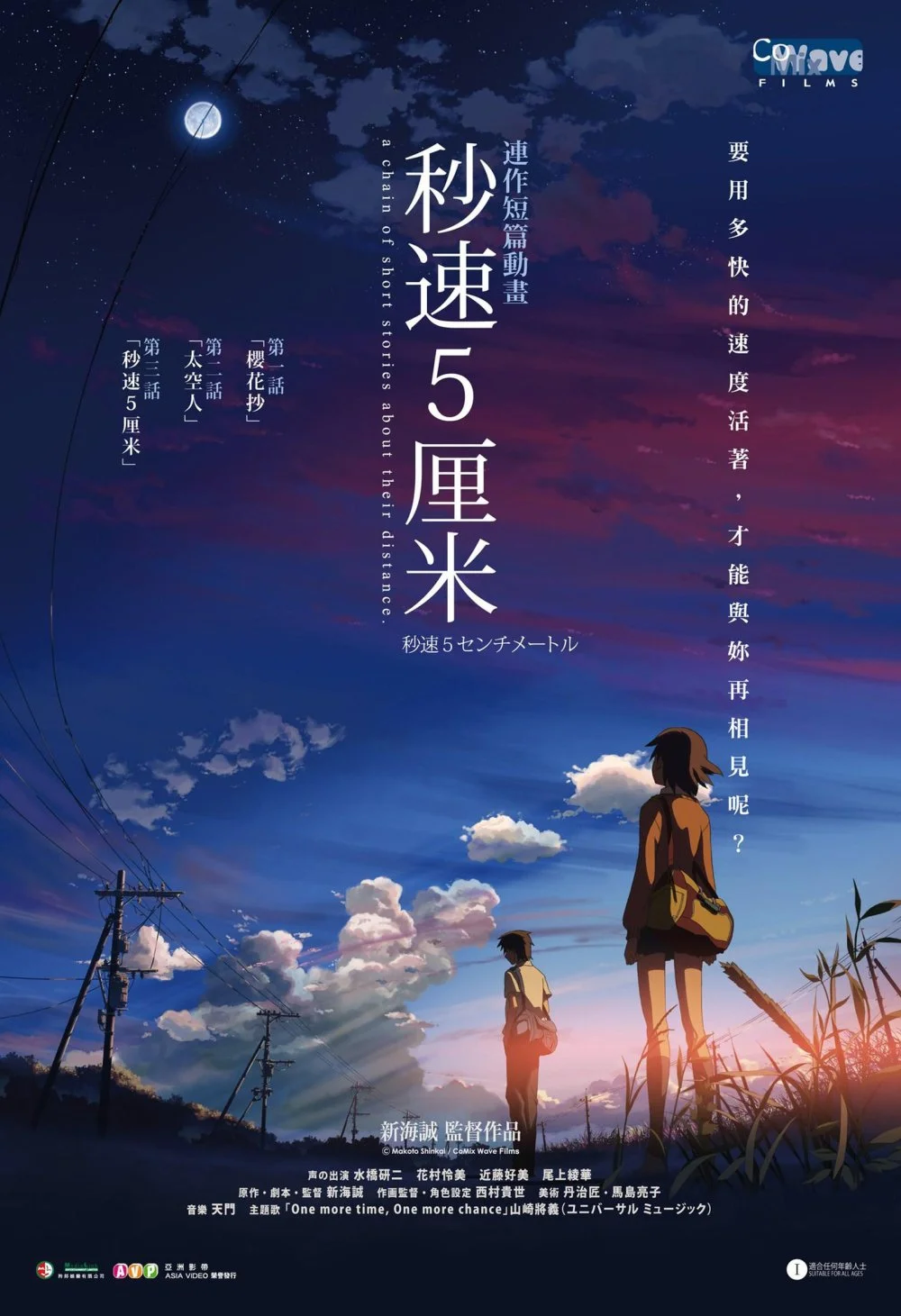
Poster of 5 Centimeters Per Second (Directed by Makoto Shinkai, 2007)/Makoto Shinkai Animation/Alamy
"5 Centimeters per Second" is a pure example of poetry and the uncertainty that you and your life are good enough to take in that one person with whom you feel at ease. "The Garden of Words" is prose, a linear narrative. "5 Centimeters" is blue, white, and yellow—from the night, snow, electricity, or from the waves, foam, and chickweed flowers. "The Garden" is green and gray. Green—from the trees, water lilies, and sedge of Shinjuku Gyoen Park in June. Gray—from the eyes, the rain on puddles, and the Yoyogi Tower in storm clouds: June in Tokyo is the rainy season. The 15-year-old protagonist, on a rainy morning, cannot bring himself to go to school. In the rain, he is drawn to wander around the city.
A gazebo in Shinjuku Gyoen, which he frequents, where he sits and makes pencil sketches of shoes (he is attracted to the craft of shoemaking), has recently become a regular haunt of a 27-year-old woman. She drinks beer in the morning, and when he reproaches her, saying she should have something to eat, she pulls out a dozen chocolate bars from her bag in response. She has lost her sense of taste, only understanding alcohol and chocolate. She has also, by her own admission, forgotten how to walk. Her drunken, lonely morning outings to the park are her attempt to return to life. The mysterious adult life, with the romance of early-day drinking and nervous breakdowns, attracts the teenager. He takes her foot measurements. Feet are possibly the most erotic and intimate part of our bodies. Our feet end up in the hands of only those we trust and with whom we feel at ease. And also—in the hands of shoemakers. Later, when the sun comes out, he will meet her at school, where she turns out to be a literature teacher, loved by an older student, whose girlfriend, out of jealousy, has resorted to mudslinging aimed at the teacher, causing a scandal.
In this film, Shinkai captures the flirtation between teenagers and their elders with surgical precision. The self-assured quips, laced with self-irony: "Where'd you get the black eye?" – "Wanted to be like you, so I drank some beer and fell off the Yamanote platform." The cocky antics, meant to both point out his companion's "advanced age" and remind her who's the man here, are met with her barely concealed admiration, rooted in her superior intellectual and emotional experience. Since the protagonist of "The Garden" is a young boy, it's as if he chooses a song for his beloved for the end credits that would remind her of when she was 12—a carefree tune, like splashing through puddles, that played on every radio in Japan in 1988:
"Not fearing the rainy storm at all,
Not fearing to get drenched to the bone,
I followed you, whistling a simple tune.
We’ve been through so much together,
And, like after our first quarrel, I beg you:
Don't leave, don't leave, stop."
The flirtation between a young boy and an older woman is another area where Shinkai is a master of the highest order. In his latest film, "Suzume no Tojimari" (Suzume, Closing Doors), the flirtation line between the "almost forty-year-old" aunt of the main heroine and the 22-year-old guy who offers to drive her from Tokyo to Kobe is the only lively element in an otherwise unsuccessful film—so lively, in fact, that it's worth enduring two hours of a derivative and somewhat dull movie just for this. In addition to the aforementioned quips, there are also 1960s songs playing on the radio—unlike the protagonist of "The Garden," who chose his song wisely, this guy doesn't realize that for his companion, they are hopelessly retro—and endless cigarettes, meant not so much to emphasize his masculinity as to remind her of the idols of her youth when the heroes of Ken Takakura and Bunta Sugawarai
Let's close the topic since we've skipped to Shinkai's latest film, bypassing his two most globally acclaimed box office hits. "Suzume" didn't work for a simple reason: Shinkai doesn't do well with girly fairy tales. Between "5 Centimeters per Second" and "The Garden," he already attempted one, "Children Who Chase Lost Voices" (2011). And right away, a kind of cuteness emerged that was completely unsuitable and unnatural for him. For example, a cat companion with ears sticking out over the girl's shoulders; in "Suzume," the cat is joined by a self-walking, talking three-legged child's chair that turns into a handsome prince. This prince, like all the other guys in "Suzume" and "Children Who Chase Lost Voices," sports smooth manes like the male leads on the covers of Harlequin romance novels—while Shinkai's usual hero is tousled but cropped short, boyishly.

Suzume no tojimari. (2022 Directed by Makoto Shinkai) /Prod DB © Toho Company - Aniplex - CoMix Wave Films - East Japan Marketing & Communications Inc/Alamy
In these films, Shinkai is clearly trying to emulate Miyazaki. In the prologue of "Suzume," the prince leads the titular heroine into a flying waltz—much like the prince in the prologue of Miyazaki's "Howl's Moving Castle" (2004)—only Shinkai's prince lacks the stylish pink diamond-patterned coat and Joe Hisaishi's waltz accompaniment, which could lift you into the clouds even without any visuals. In "Children Who Chase Lost Voices," Shinkai tries to create a Miyazaki-like European beauty: Parisian streets, knightly cloaks, saddles adorned like in tapestries, and peasant costumes like in the Romanian-Italian sword-and-sandal films of the late 1960s, such as "The Dacians" and "The Battle of Rome." But Miyazaki combines such ingredients and blends them in such proportions that a truly fairy-tale time emerges on the screen, uniting Charles Perrault and Pamela Travers. Shinkai's world of girly fairy tales is the world of a schoolboy who has watched too many old costume adventures and draws everything that has impressed him: it looks like Jean Marais riding Gojko Mitić.

A shot from Howl’s moving castle(Director Hayao Miyazaki, 2004)/Alamy
However, the most telling aspect of these failures by Shinkai is that in both cases, he abandoned his two main techniques: the subjective camera, which captures objects more than the eyes of the person opposite, and inner monologues. The stories unfold through direct dialogues, shot traditionally—two people chatting face to face. Isn't this the best self-revelation? He simply isn't able to get into a girl's head, to see the world through a girl's eyes.
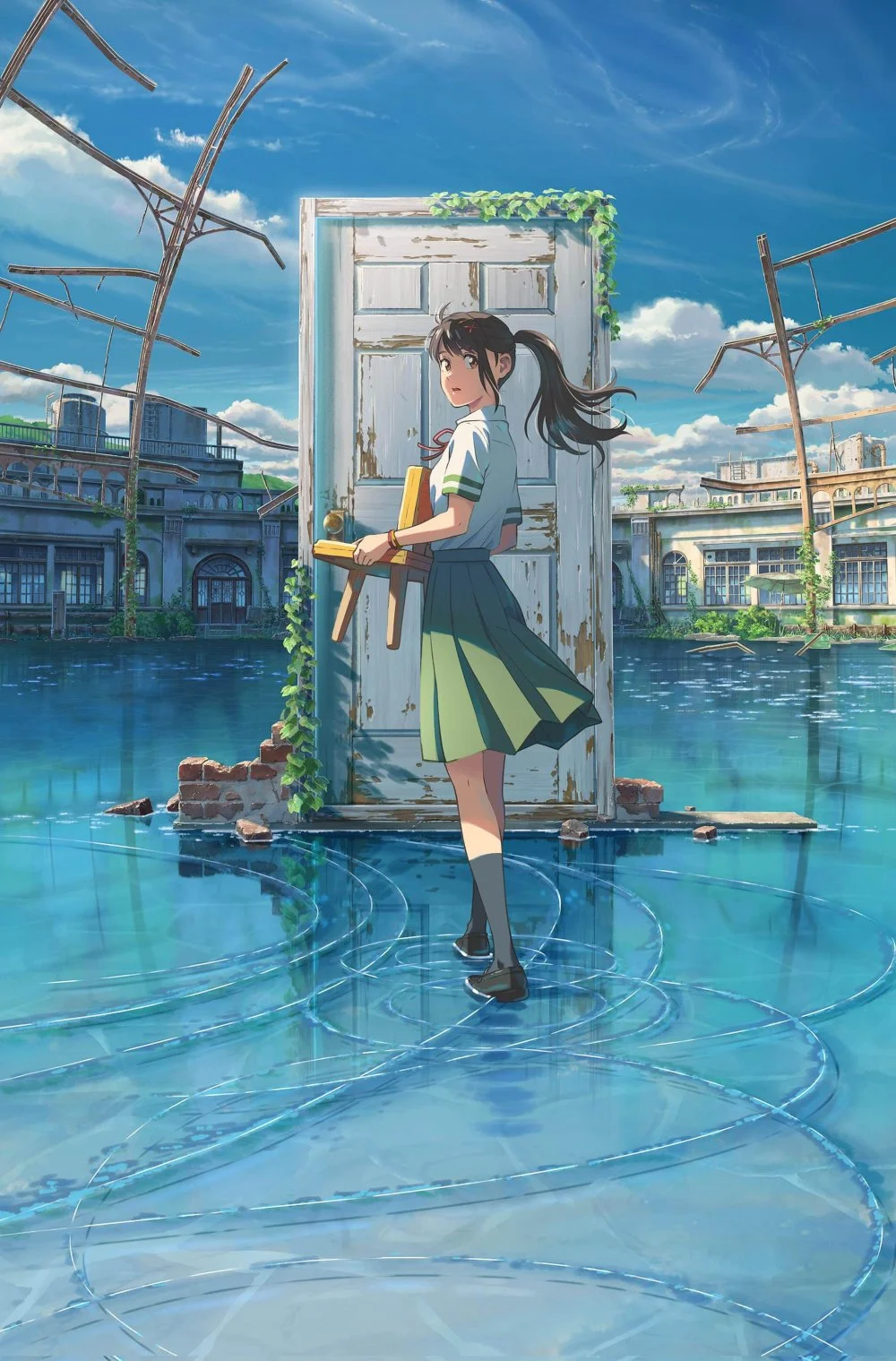
Suzume no tojimari. Directed by Makoto Shinkai (2022)/Prod DB © Toho Company - Aniplex - CoMix Wave Films - East Japan Marketing & Communications Inc/Alamy
A FAIRY TALE ABOUT SHINTOISM AND JAPANESE NOIR
That he not only mastered the modern fairy tale genre but also became one of its greatest storytellers is proven by "Your Name" (2016). We've already mentioned that this film, beneath the standard formula of flirtation—"Haven't we met somewhere before?"—discovers a deeply hidden truth. Because more often than not, when we say that to someone we're genuinely drawn to, we do feel something. And that something takes root in another seemingly banal line from the film, with which it opens: "Lately, I often wake up in tears with the feeling that I've forgotten something very important." In the realm of dreams, Shinkai discovered and proved the reality of something that, if not material, exerts such pressure on the material world that it can change the course of history and the news reports. The film begins with a tired preamble: a boy and a girl swap bodies. He, of course, spends a lot of time thoroughly touching his new breasts, much to the shock of her younger sister. Later, when they understand what's happening, they start leaving messages for each other on their phones, and she makes him promise not to touch her breasts again. This is genuinely funny—but it's just the setup. I won't retell the fairy tale itself. It's too cleverly conceived to spoil for those who haven't seen the film yet; it became the highest-grossing anime for good reason.

Taki and Mitsuha switch bodies. Your Name (Kimi no na wa, 2016 Japanese Director: Makoto Shinkai)/Makoto Shinkai Animation/Alamy
One note about Shintoism. The heroine makes sake at a village festival. She chews rice and spits the mash into a vessel where it ferments. This is so erotic that Shinkai anticipated the awkwardness some viewers might feel and introduced a scene where her classmates whisper, "How is she not embarrassed?" In Shintoism, when we take something inside ourselves, like food, we also take in the spirit of what we eat (and in Shintoism, everything has a spirit, even an old umbrella—it even has its own name, karakasa). So, in the climax, for the hero to connect with the heroine, he has to find the sealed vessels where she spat the chewed rice, and drink the sake, a third of which is made up of her saliva. The relentless, growing curiosity and excitement of "What happens next?" in this film are sustained by Shinkai's typical techniques—inner monologues, subjective camera work, and long sequences made up of rapid montages of flashbacks. Shinkai's best films are also about staying true to oneself. He admired our pliability, weakness, and susceptibility, which prevent us from being with those who make us feel at ease and the fact that this loyalty doesn't leave us. If it does, we feel such a sense of loss that we break down and stop behaving with dignity. So, in the end, we behave the way we truly want to. "Your Name" is Shinkai's triumph because, by staying true to himself and fully preserving his unique style, he created one of the most beloved fairy tales of our century, cherished by people of all ages.
Released after "Your Name," "Weathering with You" (2019) initially left some viewers with a sense of disappointment. It's also a modern fairy tale but lacks the relentless action and unpredictable twists that made "Your Name" so spectacular. Indeed, the fairy tale in "Weathering with You" is straightforward and linear. However, when revisiting the film today, already knowing what to expect from the plot, you unexpectedly find yourself deeply engrossed in its "real" story. This story is about 13- to 16-year-old teenagers in Tokyo—orphans or runaways—who, in one way or another, are living without parents.
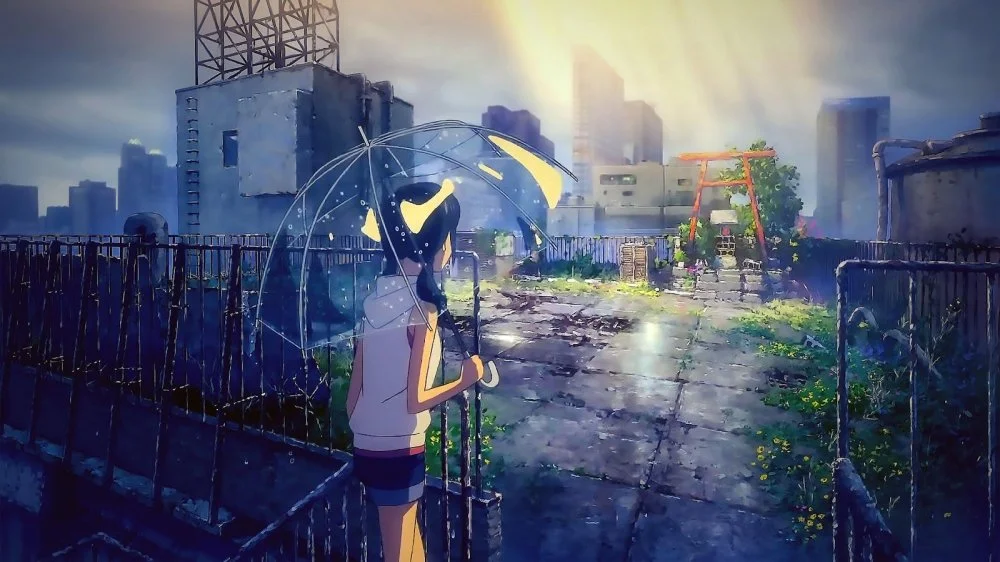
Hina climbs the abandoned temple on the roof of the house for the first time. "Weathering With You"(Directed by Makoto Shinkai 2019) /COLLECTION CHRISTOPHEL © "Weathering With You" /Alamy
Godard lamented that we will never have fair elections or worthy governments as long as the elderly, living in dementia and on subsidies, are allowed to vote, while children—who in our society include sexually mature, erudite people aged 12 to 17—are not. Shinkai's two-hour film thoroughly explores the harsh realities that these very sexually mature, erudite, and charming beings, fresh in their outlook, have to navigate when fate condemns them or they choose to live independently. They can't get jobs with social benefits, they're hunted by child protective services, who bring the police with them. For this reason, Shinkai, for the first and only time, constructed a film in the genre and style of noir.
Japanese noir was born in the late 1950s with the arrival of the unparalleled and utterly unique master of the social detective novel, Seicho Matsumoto ("Points and Lines," 1958; "The Empty Land," 1962; "In the Shadow," 1964). For the next two decades, his work had a direct impact on Japanese cinema: his novels were adapted (Yoshitaro Nomura's "Zero Focus," 1961; "The Castle of Sand," 1974; Yoji Yamada's "A Flag in the Mist," 1965), and they inspired filmmakers (Kinji Fukasaku's "High Noon for Gangsters," 1962; "Battles Without Honor and Humanity," 1973; Junya Sato's "The Bullet Train," 1975; "Proof of the Man," 1977). Even Akira Kurosawa reinterpreted Shakespeare's "Hamlet" for the Japanese context of that era as if it had been written by Matsumoto (in the film "The Bad Sleep Well", 1960).
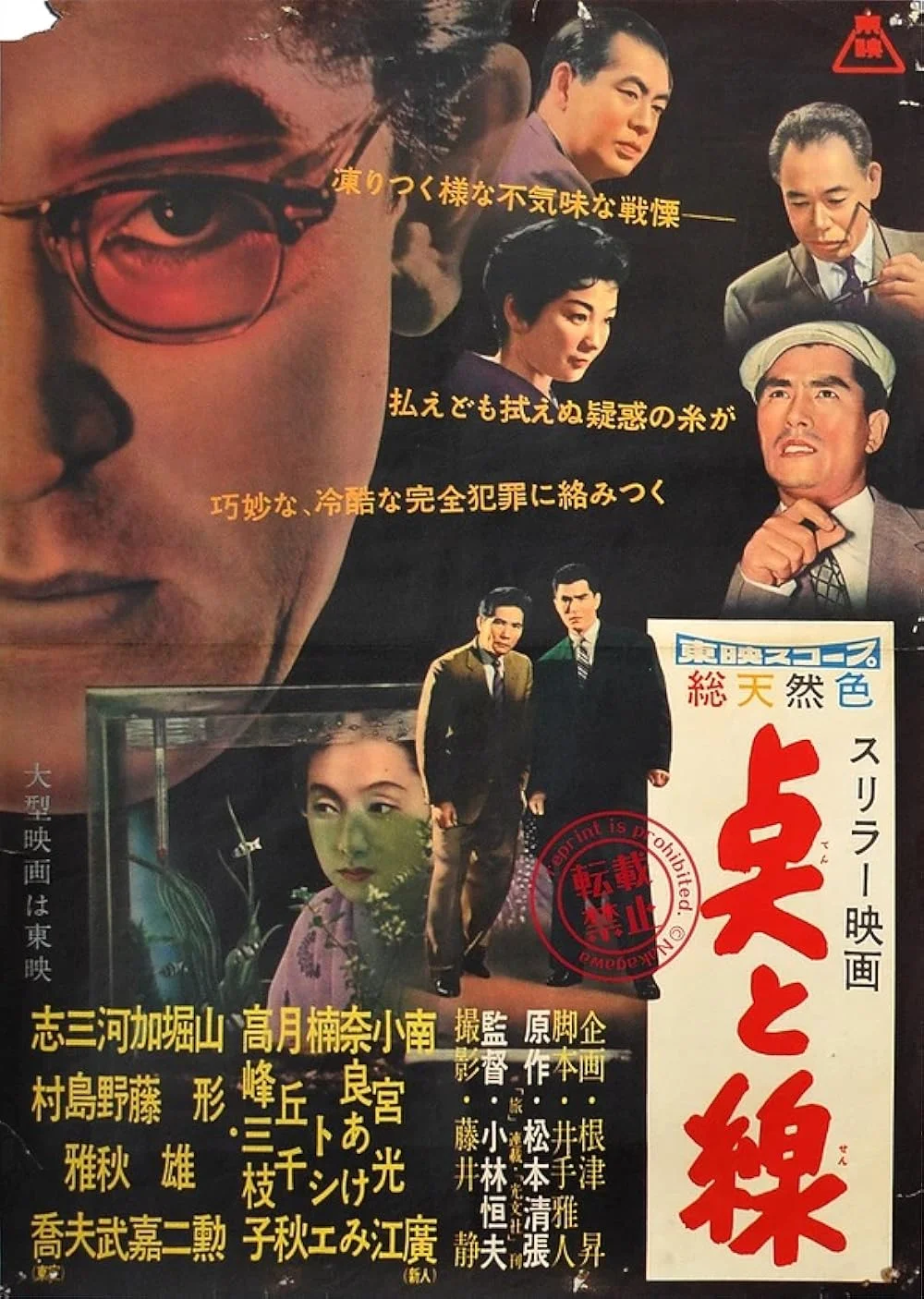
Poster of «Ten to sen» / «Point and Line» / «The Dead End» (Director: Seite Matsumoto, 1958)/From open sources
As a result, in "Weathering with You," Tokyo has been plagued by a noirish rain for two months, the police inspector sports a hairstyle reminiscent of a Leningrad cowboy and possesses the chiseled profile of Alain Delon (the main idol of the Japanese audience during Matsumoto's era), one of the main characters is a perpetually drunk tabloid editor who is forbidden by his mother-in-law from seeing his daughter because he smokes incessantly, a strip club becomes one of the key settings, and the 16-year-old protagonist ends up with a loaded gun in his hands, which he will have to fire twice.
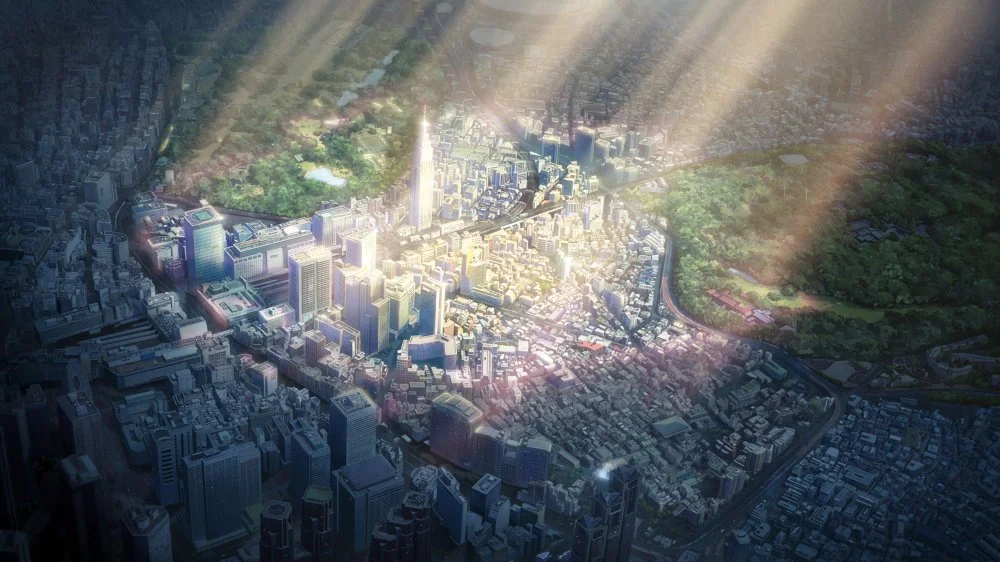
"Weathering With You"(Directed by Makoto Shinkai, 2019) /CoMix/COLLECTION CHRISTOPHEL © "Weathering With You" /Alamy
Noir became a surprising new arrangement for Shinkai’s central themes—loneliness and the yearning to be with someone who brings peace to your heart. In this film, Shinkai presents the protagonist with a dilemma: either he must lose love and peace, or central Tokyo will be submerged, and the rains will never end. The protagonist chooses love. And, in the finale, he receives absolution from Taki’s grandmother (Taki being the main character from "Your Name"): “200 years ago, when Tokyo was called Edo, this part of the city was also underwater. Then, people reclaimed the land from the water and built skyscrapers there. So, there was no catastrophe; everything just came full circle.”
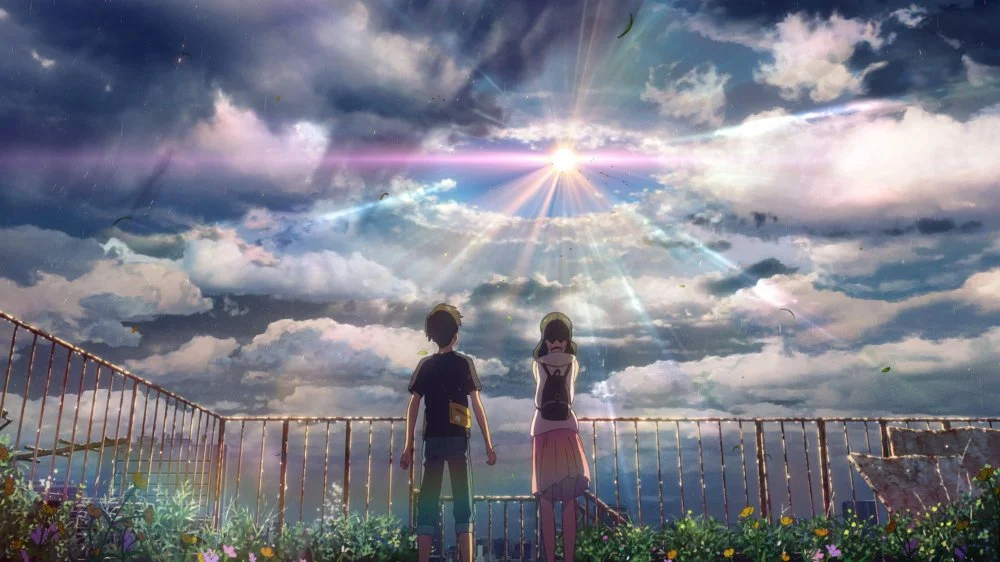
«Ауа райы балалары» анимесінен көрініс (Режиссер Макото Синкай, 2019)/CoMix/COLLECTION CHRISTOPHEL © "Weathering With You" /Alamy
So, as we’ve reviewed all of Shinkai’s films, leaving him at 51, in the prime of his life and with the potential to surprise and inspire us many more times, let’s remember the words of an old song by Valeria, which are fitting in light of the grandmother’s epitaph to what he has already created:
“For love, you gave everything,
All the floors of skyscrapers,
For love, you were willing to die—
Because love is bigger than life.”
Five Films That Reveal Everything About Shinkai
“As a Director"
"5 Centimeters per Second" (2007): If "Eugene Onegin" is a novel in verse, this is a film in verse. It is composed of subjective perspectives, internal monologues, and a music video-style montage to vividly and thoroughly tell the story of 12 years of all-consuming mundanity.
"As a Storyteller"
"Your Name" (2016): The most unpredictable fairy tale, in which Shinkai, with the conviction of a Shinto believer, proves the materiality of the most precious and elusive thing we have—dreams.
"As a Man"
"The Garden of Words" (2013): An encyclopedia of flirtation between a high school boy and an adult woman under the sound of rain. Also: "Suzume" (2022) featuring the storyline of a “nearly 40-year-old” aunt and a college senior who offers to drive her from Tokyo to Kobe.
"As a Romantic"
"Voices of a Distant Star" (2002): A film composed of text messages sent between lovers across eight light-years between Earth and space.
"As a Citizen"
"Weathering with You" (2019): A neo-noir film defending the right of teenagers to live independently.
